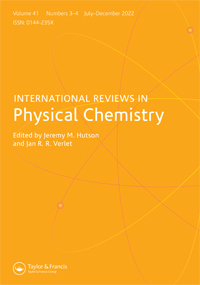模拟具有复杂结构的磁团簇的性质:对称性如何帮助我们
IF 2.5
2区 化学
Q3 CHEMISTRY, PHYSICAL
引用次数: 2
摘要
本文的目的是回答对称性如何帮助我们研究和理解具有复杂结构的纳米级磁团簇的性质。选择的体系将是三种类型的多金属氧酸盐(POMs):(1)含有局部自旋的POMs;(2)还原混价聚甲醛(MV);(3)局部和局部亚基共存并相互作用的局部离域POMs。基于各种对称性的理论工具有:(1)基于所谓“自旋对称性”和MAGPACK程序的不可约张量算子(ITO)方法;(2)基于自旋和点对称的交换多重态群论赋值;(3)对MV - POMs的离域电子态和电子振动态进行群论分类;(4)基于自旋对称的大MV团簇能级评估方法及相应的MVPACK程序;(5)采用点对称计算方法求解纳米系统中多维非绝热振动问题。我们的目标是避免传统的演绎风格。相反,我们首先考虑特别选择的复杂pom,然后展示用什么方法和什么方式可以适当地解决在描述这些分子性质时产生的理论问题。本文章由计算机程序翻译,如有差异,请以英文原文为准。
Modelling the properties of magnetic clusters with complex structures: how symmetry can help us
The purpose of this article is to answer the question of how symmetry helps us to investigate and understand the properties of nanoscopic magnetic clusters with complex structures. The systems of choice will be the three types of polyoxometalates (POMs): (1) POMs containing localised spins; (2) reduced mixed-valence (MV) POMs; (3) partially delocalised POMs in which localised and delocalised subunits coexist and interact. The theoretical tools based on various kinds of symmetry are the following: (1) irreducible tensor operator (ITO) approach based on the so-called “spin-symmetry” and MAGPACK program; (2) group-theoretical assignment of the exchange multiplets based on spin- and point symmetries; (3) group-theoretical classification of the delocalised electronic and electron-vibrational states of MV POMs; (4) general approach (based on spin symmetry) to evaluate the energy levels of large MV clusters and the corresponding MVPACK program; (5) computational approach (employing point symmetry) to solve multidimensional non-adiabatic vibronic problems in the nanoscopic systems realized as VIBPACK software. We made it our goal to avoid a conventional deductive style of presentation. On the contrary, we first consider specially selected complex POMs and then show by what methods and in what way the theoretical problems arising in the description of the properties of these molecules can be properly solved.
求助全文
通过发布文献求助,成功后即可免费获取论文全文。
去求助
来源期刊
CiteScore
14.20
自引率
1.60%
发文量
5
审稿时长
1 months
期刊介绍:
International Reviews in Physical Chemistry publishes review articles describing frontier research areas in physical chemistry. Internationally renowned scientists describe their own research in the wider context of the field. The articles are of interest not only to specialists but also to those wishing to read general and authoritative accounts of recent developments in physical chemistry, chemical physics and theoretical chemistry. The journal appeals to research workers, lecturers and research students alike.

 求助内容:
求助内容: 应助结果提醒方式:
应助结果提醒方式:


